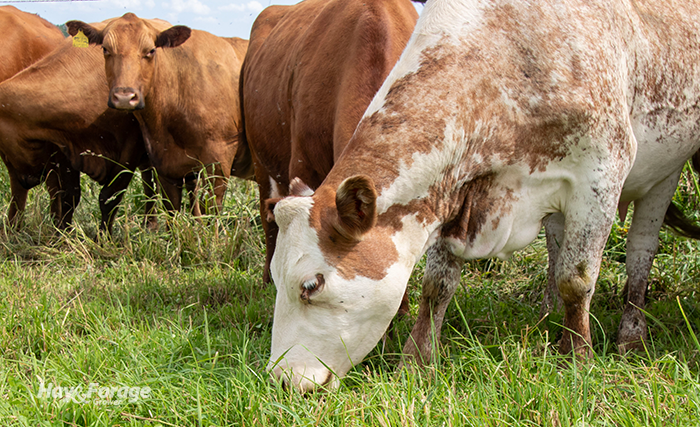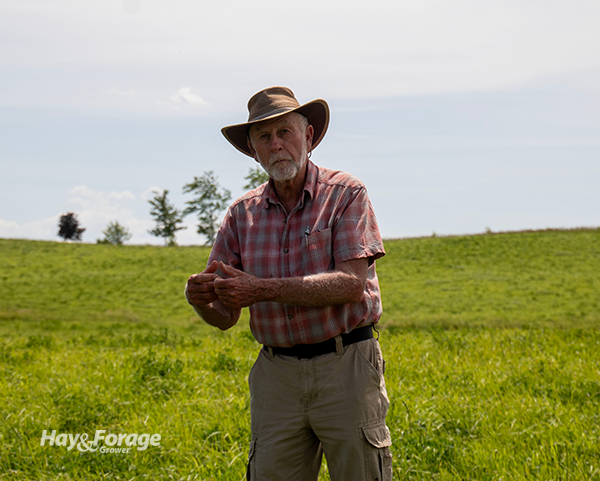
Perhaps the best way to understand grazing livestock and forage management from a fresh perspective is to walk a mile in someone else’s shoes — or in their pasture. Whether you are a beginning grazier or a veteran rancher, exploring other systems can inspire new strategies and offer new solutions to routine challenges on your own operation.
Jim Gerrish has witnessed a spectrum of systems with over 40 years of grazing experience in diverse regions of the United States. After conducting grazing research and outreach in the hot and humid Show-Me State for over 20 years with the University of Missouri, he moved to Idaho to continue grazing livestock in the cool and dry Pahsimeroi Valley. He shares his expertise as an author, speaker, and grazing consultant, in addition to hosting grazing workshops and pasture walks across the country.

Last week, Gerrish hosted one such pasture walk at Starry Nights Farm near Burlington, Wis. The rotational grazing beef farm comprises roughly 140 acres and about 30 head of cows.
Attendees took their first steps of the pasture walk through a mixed stand that had already been grazed once and then cut for hay. Gerrish threw his wide-brimmed hat into the field like a frisbee and instructed the group to circle up around its landing point. Then, he asked attendees to pluck a single grass tiller from the ground and determine, based on its stage of regrowth, whether forage was ready to be grazed again.
“How do you know when a pasture is recovered?” he prompted.
Gerrish noted that counting growing degree days is not a reliable strategy to gauge pasture readiness. Cool-season grass development is driven by photoperiod, not growing degree days. Therefore, as day lengths get longer, cool-season grasses reach maturity faster.
Instead, he suggested assessing leaf stage, or the number of fully emerged leaves with collars that have formed between the blades and the sheaths. In this case, the group determined the average leaf stage in the pasture was roughly three and a half, indicating that the stand had transitioned from Phase 1 to Phase 2.
Phase 1: The lag phase. Regrowth is slow immediately after a harvest event because there is no longer enough leaf area to facilitate photosynthesis and support plant growth. At this point, forage is drawing upon stored carbohydrates in the roots for energy.
“We would call the energy flow in a plant at anything less than two-and-a-half leaf stage a negative carbohydrate balance,” Gerrish explained. “When we get three leaves, then there is enough photosynthetic activity to support the ongoing growth and begin to restore root carbohydrates. If you are in one leaf stage, one and a half leaf stage, or two leaf stage, do not graze it,” he added. “If you do, you will just push plants farther into demand for that stored energy.”
Phase 2: The rapid growth phase. Plant growth in this phase is driven by leaf area. Gerrish said the primary business of farming and ranching is not producing milk, meat, and fiber. Rather, it is capturing solar energy with forage crops, and through photosynthesis and grazing, turning that energy into those saleable products.
The veteran grazier recommended using a photometer to measure photosynthetically available radiation in a pasture; however, he can usually estimate this number within a few percentage points of the calculated value. He pegged solar capture in the pasture at Starry Nights Farm was about 28%.
“Every additional day the grass grows, it is going to be working toward that maximum potential of 80% to 85% solar capture,” Gerrish stated. He added no plant community on the planet is capable of 100% solar capture. But as pastures absorb more photosynthetically available radiation, forage growth begins to enter Phase 3, which is when plants become reproductive and quality starts to decline.
Phase 3: The reproductive phase. Gerrish explained that once the flag leaf emerges, there is no longer potential for any more leaf growth on an individual tiller. Instead, plants put all of their energy toward seed development.
“Once we get to this point, we have what I call a ‘stale solar panel,’” he said. “We still have photosynthesis going on, we are still flowing energy to the roots, we are still flowing energy to the microbes in the soil, but we have reached the peak yield that the tiller has. There is no advantage to letting a pasture sit beyond Phase 3.”
With an average leaf stage of three and a half, Gerrish decided it was too early to regraze the pasture at Starry Nights Farm and suggested waiting until the grass had an average of four or five collared leaves. This would ensure forage can replenish its root reserves while capturing 60% to 70% of photosynthetically available radiation yet harvesting it before quality drops off.
After this exercise, attendees made their way through a second pasture that had a noticeably strong legume component compared to the first. The group gathered in a circle around Gerrish once again as he explained how the horizontal growth pattern of legume leaves in conjunction with the vertical growth pattern of grass leaves maximizes surface area for solar capture. He added that the ideal percentage of legumes in a mixed pasture is between 30% to 40%.
Other conversations ensued as attendees ambled across the acres, covering topics like frost seeding, fly control, weed control, and herd genetics. The audience wove insightful questions and helpful advice into Gerrish’s teachings, and it is with this exchange of information and ideas that makes pasture walks unique and nuanced learning environments.

